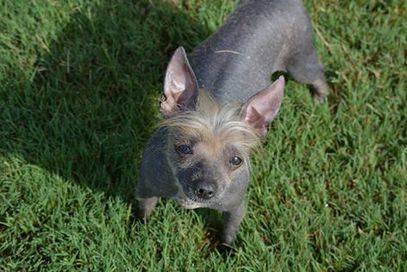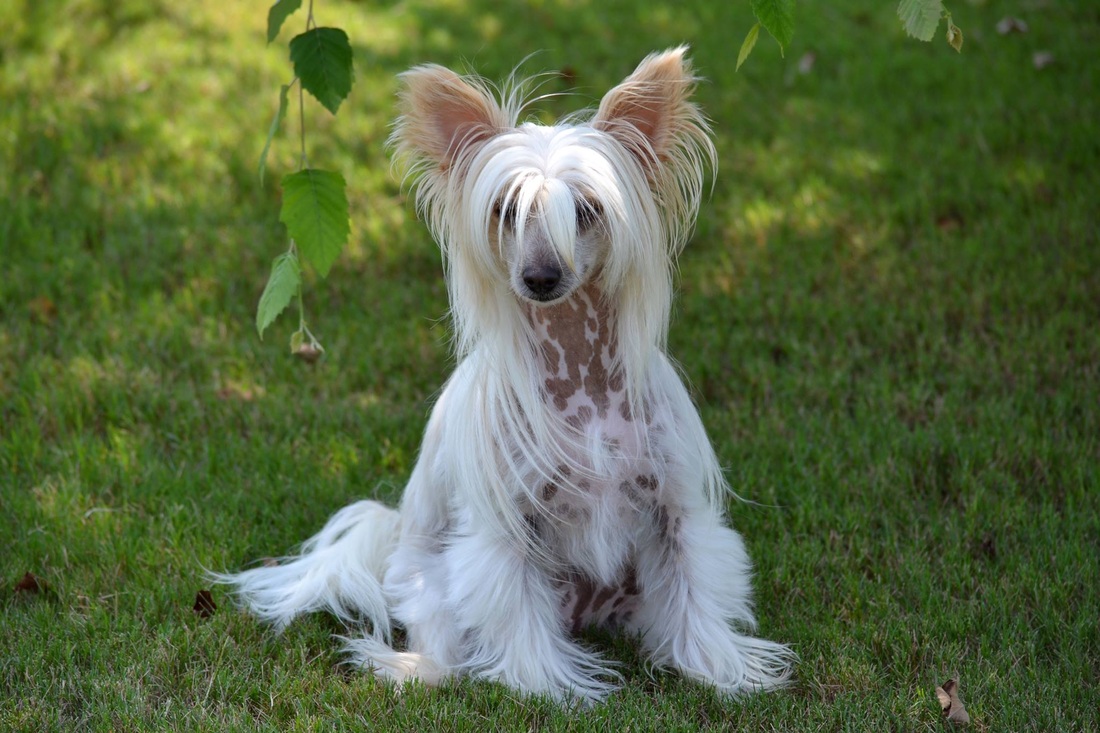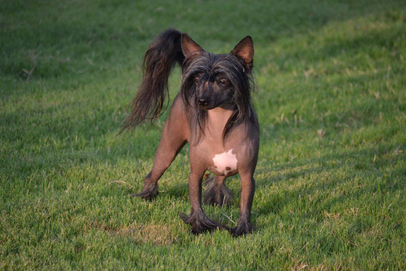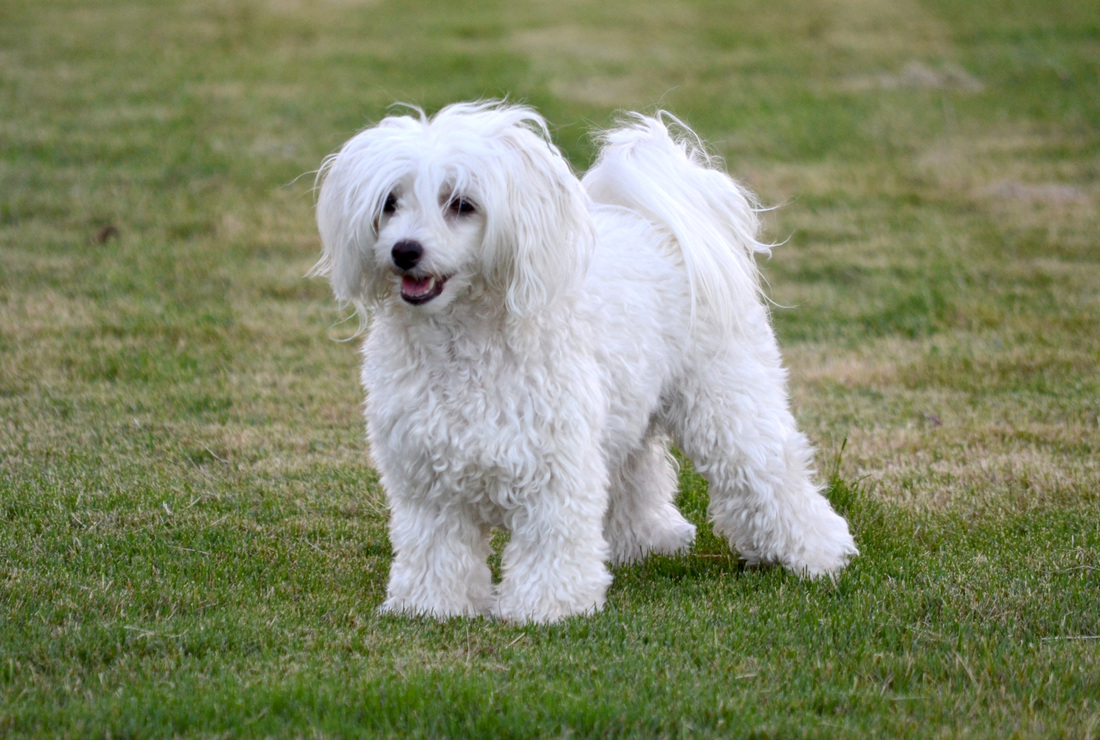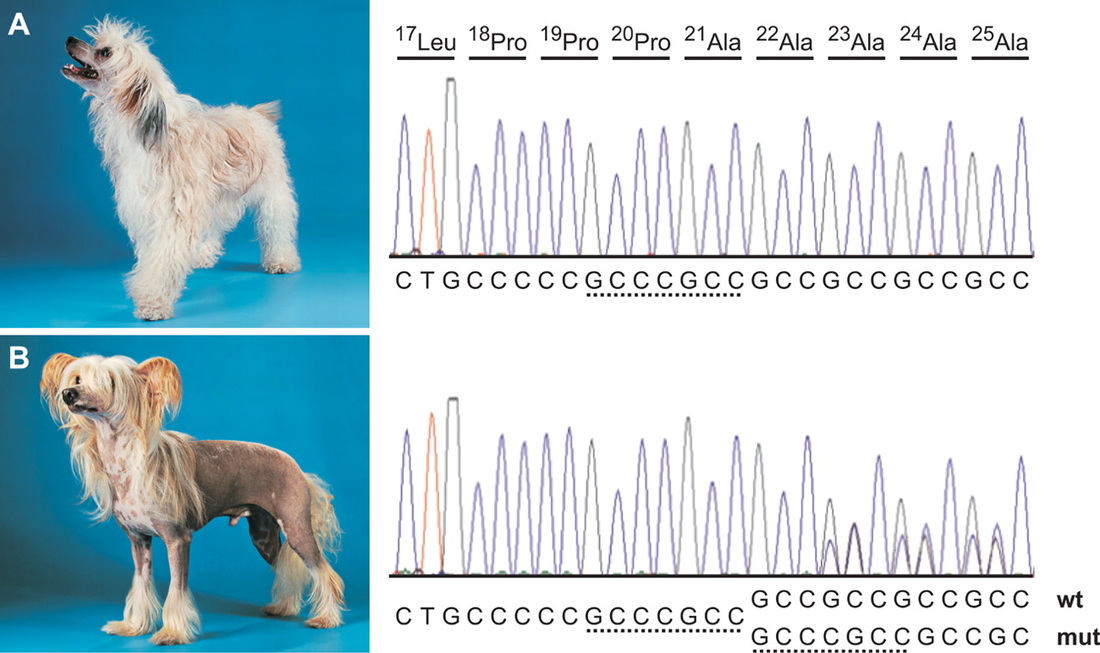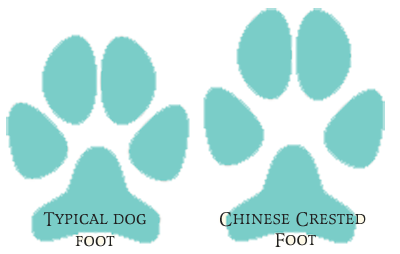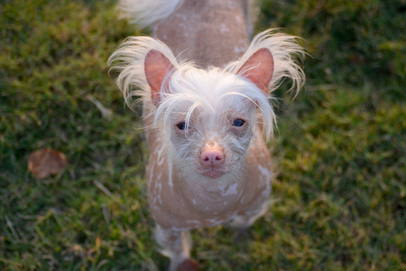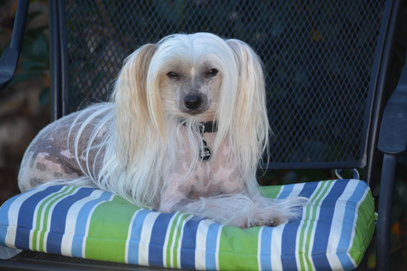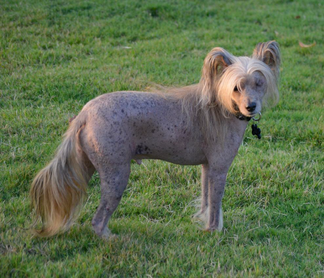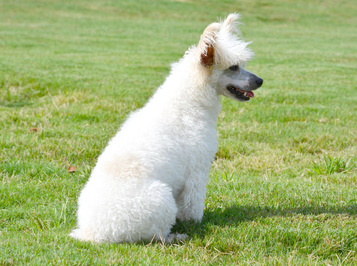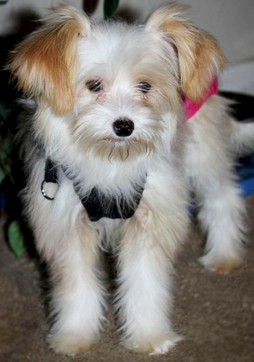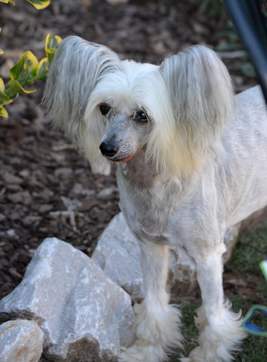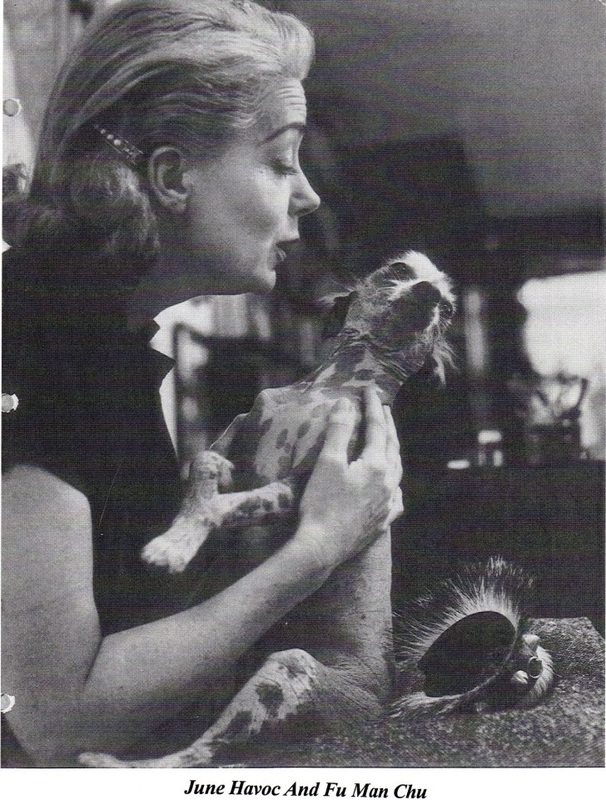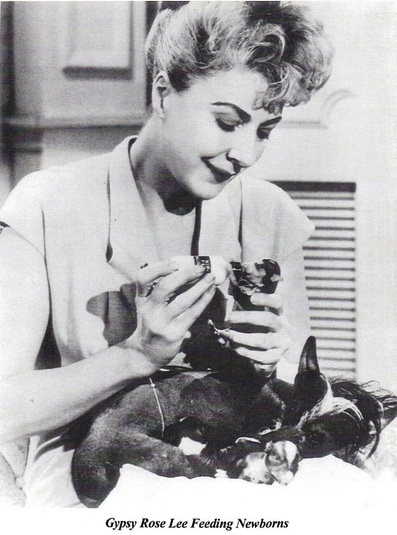THE CHINESE CRESTED
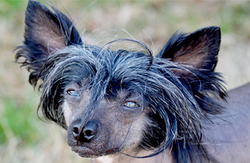
GENERAL
The Chinese Crested, fondly called the Crestie or Puff, comes in two “types:” the hairless and the Powderpuff. The Hairless type has soft, human like skin, as well as tufts of fur on its paws ("socks"), tail ("plume") and long, flowing hair on its head ("crest").
The Powderpuff has a long, soft, fine, double coat. The term hairless is used loosely as most of the hairless Chinese Cresteds do in fact have hair, and sometimes lots of it. Most owners use the following terms to describe the “type” of Chinese Crested that they have: True Hairless, Hairless, Hairy Hairless, and Powderpuff.
When it comes to teeth, the Powderpuff “wins.” The puffs possess a normal dentition/set of teeth, while the Hairless Crestie does not. The hairless have what is called a primitive dentition which consists of forward pointing, tusk like canines and almost always lose or have missing teeth as adults.
The Chinese Crested, fondly called the Crestie or Puff, comes in two “types:” the hairless and the Powderpuff. The Hairless type has soft, human like skin, as well as tufts of fur on its paws ("socks"), tail ("plume") and long, flowing hair on its head ("crest").
The Powderpuff has a long, soft, fine, double coat. The term hairless is used loosely as most of the hairless Chinese Cresteds do in fact have hair, and sometimes lots of it. Most owners use the following terms to describe the “type” of Chinese Crested that they have: True Hairless, Hairless, Hairy Hairless, and Powderpuff.
When it comes to teeth, the Powderpuff “wins.” The puffs possess a normal dentition/set of teeth, while the Hairless Crestie does not. The hairless have what is called a primitive dentition which consists of forward pointing, tusk like canines and almost always lose or have missing teeth as adults.
EXAMPLES OF HAIR AMOUNTS
PERSONALITY
This breed is exceptionally loving, playful and entertaining, but can be on the shy, timid side with strangers if not properly socialized at an early age. They can further be described as intuitive and intelligent, excelling in both agility and as a therapy dog. While they are playful and energetic, they are more than happy to lie down and cuddle if that is desired, which makes them excellent for apartment/city life.
REACTIONS
The Chinese Crested is stereotyped as "the ugly dog," and Chinese Crested mixes have dominated the "ugly dog" contest for years, however this breed is elegant, beautiful and deserves love and respect.
There are many reactions that you may experience while owning this breed. Most reactions are ones of curiosity and amazement where they want to touch your dog and ask you questions. Other reactions can be rude and hurtful, they may act disgusted, frightened and sometimes even angry as they think that you have brought a dog with mange or another disease out in public.
Sadly, we have seen many dogs surrendered by their owners because they were embarrassed and could not handle the reactions from friends, family and strangers. You must truly love and admire this breed to be able to put that aside. That being said, these people are actually providing you with a great opportunity to inform and educate them on the hairless breeds! Read more on the Chinese Crested below!
CARE
Both "types" of the Chinese Crested will require grooming. The Powderpuff has a fine double coat that will require regular daily brushing to prevent matting as well as regular sanitary grooming. Many Powderpuff owners choose to groom their puffs, in an effort to prevent matting, in the "Pony Cut." This involves shaving the Powderpuff to resemble their hairless counterpart. Interestingly, the PowderPuff's coat does not continuously grow, once it reaches it’s full length, which is quite long, it stops. Once it is cut, it resumes growth. Interesting right!? The AKC breed standard calls for the powderpuff to have a straight coat, however, the powderpuff will often times possess a wavy coat to curly coat, especially if left to air dry.
The Hairless Chinese Crested also requires regular grooming in order to keep the skin and hair neat and tidy. This process usually involves bathing with a gentle dog shampoo, trimming/shaving stray hairs/lockets along the back, upper legs, chest, face and ears. Hairlessness varies a great deal due to how the hairless gene (explained in greater detail below) expresses its self in each individual dog, so a Hairless Chinese Crested with more hair will require more grooming.
The grooming of the Hairless Chinese Cresteds skin is similar to that of grooming human skin; it is even susceptible to acne like: blackheads, whiteheads and pustules. The skin is also prone to dryness, and sunburn. Bathing should be based on the individual dog as too much can mess with the PH balance and cause more issues and too little will do the same. It is a delicate balance.
Most important to note is that the hairless Chinese Crested has very little natural protection and is prone to contact allergens, bites and stings. Some are even allergic to lanolin and wool, so be cautious when using any products/items that may contain it.
This breed is exceptionally loving, playful and entertaining, but can be on the shy, timid side with strangers if not properly socialized at an early age. They can further be described as intuitive and intelligent, excelling in both agility and as a therapy dog. While they are playful and energetic, they are more than happy to lie down and cuddle if that is desired, which makes them excellent for apartment/city life.
REACTIONS
The Chinese Crested is stereotyped as "the ugly dog," and Chinese Crested mixes have dominated the "ugly dog" contest for years, however this breed is elegant, beautiful and deserves love and respect.
There are many reactions that you may experience while owning this breed. Most reactions are ones of curiosity and amazement where they want to touch your dog and ask you questions. Other reactions can be rude and hurtful, they may act disgusted, frightened and sometimes even angry as they think that you have brought a dog with mange or another disease out in public.
Sadly, we have seen many dogs surrendered by their owners because they were embarrassed and could not handle the reactions from friends, family and strangers. You must truly love and admire this breed to be able to put that aside. That being said, these people are actually providing you with a great opportunity to inform and educate them on the hairless breeds! Read more on the Chinese Crested below!
CARE
Both "types" of the Chinese Crested will require grooming. The Powderpuff has a fine double coat that will require regular daily brushing to prevent matting as well as regular sanitary grooming. Many Powderpuff owners choose to groom their puffs, in an effort to prevent matting, in the "Pony Cut." This involves shaving the Powderpuff to resemble their hairless counterpart. Interestingly, the PowderPuff's coat does not continuously grow, once it reaches it’s full length, which is quite long, it stops. Once it is cut, it resumes growth. Interesting right!? The AKC breed standard calls for the powderpuff to have a straight coat, however, the powderpuff will often times possess a wavy coat to curly coat, especially if left to air dry.
The Hairless Chinese Crested also requires regular grooming in order to keep the skin and hair neat and tidy. This process usually involves bathing with a gentle dog shampoo, trimming/shaving stray hairs/lockets along the back, upper legs, chest, face and ears. Hairlessness varies a great deal due to how the hairless gene (explained in greater detail below) expresses its self in each individual dog, so a Hairless Chinese Crested with more hair will require more grooming.
The grooming of the Hairless Chinese Cresteds skin is similar to that of grooming human skin; it is even susceptible to acne like: blackheads, whiteheads and pustules. The skin is also prone to dryness, and sunburn. Bathing should be based on the individual dog as too much can mess with the PH balance and cause more issues and too little will do the same. It is a delicate balance.
Most important to note is that the hairless Chinese Crested has very little natural protection and is prone to contact allergens, bites and stings. Some are even allergic to lanolin and wool, so be cautious when using any products/items that may contain it.
|
GENETICS
A team of European scientists, led by Tosso Leeb of the University of Berne in Switzerland, searched for years for the genetic roots of the Chinese Crested’s lack of hair and abnormal dentition. Research has finally revealed that the hairless mutation results from the duplication/mutation of 7 base pair nucleotides in the genetic code, named FOXI3, in a gene on chromosome 17. This mutation causes the expression of hairlessness and abnormal dentition in the Chinese Crested. Analysis of DNA samples from 140 hairless dogs (Xolos, Peruvian Inca Orchids and Chinese Cresteds) and 87 coated dogs confirmed that every coated dog in the study lacked the mutation, and every hairless dog possessed one copy. Researchers were unable to find a single instance of a matched pair of genes containing this seven letter DNA duplication. |
MORE EXAMPLES OF HAIR AMOUNTS
BREEDS THAT CHINESE CRESTEDS ARE OFTEN CONFUSED FOR
GYPSY ROSE LEE AND JUNE HAVOC
Two of the most well known ladies in the Chinese Crested world are “The Burlesque dancer”, Gypsy Rose Lee and her sister June Havoc. Their first encounter with a Chinese Crested was when June Havoc visited a human society and brought home Fu Man Chu, who she gave to Gypsy Rose Lee. Today, most all Chinese Cresteds can be traced back to their lines and
subsequently Ida Garrett and long-time friend Debra Woods of Crest-Haven Kennels. For nearly 40 years the, two ladies worked together to promote the breed in the United States. Interestingly, the first Chinese Crested to be recognized
and registered was in 1881 in Great Britain and in 1979 the breed was finally recognized by the American Kennel Club (AKC).
Two of the most well known ladies in the Chinese Crested world are “The Burlesque dancer”, Gypsy Rose Lee and her sister June Havoc. Their first encounter with a Chinese Crested was when June Havoc visited a human society and brought home Fu Man Chu, who she gave to Gypsy Rose Lee. Today, most all Chinese Cresteds can be traced back to their lines and
subsequently Ida Garrett and long-time friend Debra Woods of Crest-Haven Kennels. For nearly 40 years the, two ladies worked together to promote the breed in the United States. Interestingly, the first Chinese Crested to be recognized
and registered was in 1881 in Great Britain and in 1979 the breed was finally recognized by the American Kennel Club (AKC).
DISEASES THAT CAN AFFECT THE CHINESE CRESTED
PRA (Progressive Retinal Atrophy) is a slow progressive hereditary disease which causes retinal dysplasia or degeneration. The age of onset of clinical signs varies, but the endpoint is blindness. Genetic testing can be done to detect the presence of one form of PRA known as prcd-PRA.
Progressive rod-cone degeneration (PRCD) is another form of PRA, it causes cells in the retina at the back of the eye to degenerate and die, even though the cells seem to develop normally early in life. The “rod” cells operate in low light levels and are the first to lose normal function. Night blindness results. Then the “cone” cells gradually lose their normal
function in full light situations. Most affected dogs will eventually be blind.
Primary Lens Luxation (PLL) is an inherited disease. It causes the lens of the eye to become partially dislocated (Lens Subluxation) or fully dislocated (Lens Luxation) from its normal position. This dislocation causes movement of the lens forward through the pupil or backwards into the Vitreous Chamber of the eye and requires immediate veterinary attention. The displaced lens may be removed to prevent painful secondary glaucoma, and sometimes loss of vision. Genetic testing is available to identify the genes that cause the disease.
Keratoconjunctivitis sicca (KCS) or dry eye syndrome (DES) is an eye disease caused by abnormal tear production. The lacrimal glands produce the watery secretions that make up the bulk of the tears. A deficiency in this secretion causes KCS.
Legg-Pethes also known as Calves-Pethes is the spontaneous degeneration of the head on the femur bone, located in the dog's hind leg. This results in disintegration of the hip joint (coxofemoral) and bone and joint inflammation
Luxating Patellas is the slipping of the kneecap out of the groove in the femur bone due to poor alignment, weak ligaments or insufficient groove.
ADDITIONAL INFORMATION
Training
Reliably potty training a Chinese Crested is one thing that few have accomplished however, it can be done. Click Potty Training for tips on how to successfully potty train your dog.
Discipline & Training
At no time should you hit your dog. Dogs respond exceptionally well to positive re-enforcement such as praise and treat training. When they do something right, praise them and give them a treat. If they do something unwanted, speak in a
sharp, firm tone "no" and gently show them what you want and when they do it, give praise and a treat; this is usually all that you need to do. You want your dog to respect you, not fear you, as fear can cause other unwanted issues to appear.
If you are having trouble training your dog, or are getting so frustrated that you feel that you cannot take any more, please contact a qualified trainer and let them help you. Sometimes proper technique and assurance is all that you need to resolve the issue.
Hypoallergenic?
Lastly, humans with allergies are often told that the Chinese Crested is 'hypoallergenic'. No dog is truly hypoallergenic,’ however, Chinese Cresteds shed little to no dander & hair, because of that they are often recommended for those with allergies.
PRA (Progressive Retinal Atrophy) is a slow progressive hereditary disease which causes retinal dysplasia or degeneration. The age of onset of clinical signs varies, but the endpoint is blindness. Genetic testing can be done to detect the presence of one form of PRA known as prcd-PRA.
Progressive rod-cone degeneration (PRCD) is another form of PRA, it causes cells in the retina at the back of the eye to degenerate and die, even though the cells seem to develop normally early in life. The “rod” cells operate in low light levels and are the first to lose normal function. Night blindness results. Then the “cone” cells gradually lose their normal
function in full light situations. Most affected dogs will eventually be blind.
Primary Lens Luxation (PLL) is an inherited disease. It causes the lens of the eye to become partially dislocated (Lens Subluxation) or fully dislocated (Lens Luxation) from its normal position. This dislocation causes movement of the lens forward through the pupil or backwards into the Vitreous Chamber of the eye and requires immediate veterinary attention. The displaced lens may be removed to prevent painful secondary glaucoma, and sometimes loss of vision. Genetic testing is available to identify the genes that cause the disease.
Keratoconjunctivitis sicca (KCS) or dry eye syndrome (DES) is an eye disease caused by abnormal tear production. The lacrimal glands produce the watery secretions that make up the bulk of the tears. A deficiency in this secretion causes KCS.
Legg-Pethes also known as Calves-Pethes is the spontaneous degeneration of the head on the femur bone, located in the dog's hind leg. This results in disintegration of the hip joint (coxofemoral) and bone and joint inflammation
Luxating Patellas is the slipping of the kneecap out of the groove in the femur bone due to poor alignment, weak ligaments or insufficient groove.
ADDITIONAL INFORMATION
Training
Reliably potty training a Chinese Crested is one thing that few have accomplished however, it can be done. Click Potty Training for tips on how to successfully potty train your dog.
Discipline & Training
At no time should you hit your dog. Dogs respond exceptionally well to positive re-enforcement such as praise and treat training. When they do something right, praise them and give them a treat. If they do something unwanted, speak in a
sharp, firm tone "no" and gently show them what you want and when they do it, give praise and a treat; this is usually all that you need to do. You want your dog to respect you, not fear you, as fear can cause other unwanted issues to appear.
If you are having trouble training your dog, or are getting so frustrated that you feel that you cannot take any more, please contact a qualified trainer and let them help you. Sometimes proper technique and assurance is all that you need to resolve the issue.
Hypoallergenic?
Lastly, humans with allergies are often told that the Chinese Crested is 'hypoallergenic'. No dog is truly hypoallergenic,’ however, Chinese Cresteds shed little to no dander & hair, because of that they are often recommended for those with allergies.

